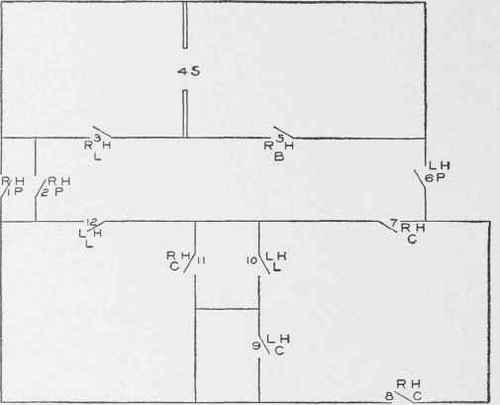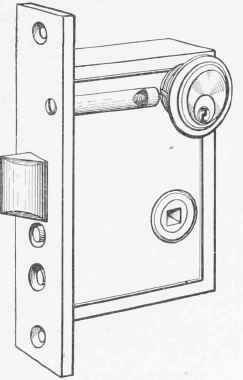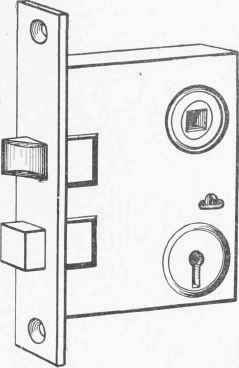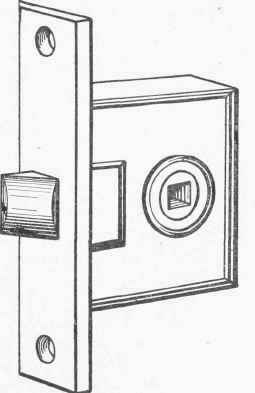Hinges And Butts. Part 5
Description
This section is from the book "Cyclopedia Of Architecture, Carpentry, And Building", by James C. et al. Also available from Amazon: Cyclopedia Of Architecture, Carpentry And Building.
Hinges And Butts. Part 5
It is often desired that locks be master-keyed - that is, so constructed that each lock will be operated by a key differing from any other, but also so made that one master key can open all, as in the case of office buildings, for janitors' use, and in hotels to accommodate the service. This requirement is always unfortunate, as it permits the passage of every lock in the series by one key. This is like very securely guarding several entrances to an enclosure and leaving one gate with but little protection; and it is much better to cause the janitor a little additional trouble by requiring him to carry a separate key for each lock. If the master key is lost, the only remedy is to change the entire line of locks.
There should be no identifying marks on keys or rings indicating the location of the locks they will operate, for, in case of loss, the finder would thus be enabled to use them.
In selecting locks for any particular building, a careful diagram or floor-plan should be prepared, on which the swing of all doors is indicated and each door numbered (see Fig. 33). A right-hand (R. H.) door is one which when opened away from a person has its butts on the right-hand jamb; and a left-hand (L. H.) door has its butts on the left-hand jamb. All latches are either R. H. or L. H.
while many types are made so that by reversing some of the mechanism they can be changed from R. H. to L. H. It is better to get an unchangeable latch, which is less complicated in its mechanism and will work easier and last longer than one with interchangeable parts.
The doors on which it is intended to place locks with pass keys (Fig. 34)- such as front and back outside doors - should be indicated; as should also those doors it is desired to lock on the inside by key (as pantry or closet doors, Fig. 35), those it is desired to bolt (as bedroom doors, Fig. 36), those requiring simple latches without lock or bolt (as doors from hall to dining room, Fig. 37), and sliding doors, which require an entirely different type of lock (Fig. 38). A bill can be made somewhat on this line:

Fig. 33. Typical Floor-Plan Showing Location and Swing of Doors.
2 | Right-hand locks with pass keys, marked | R. H.-P | Nos. 1-2, |
1 | Left " " " " " " | L. H.-P | " 6, |
1 | Right " latch " | R. H.-L | " 3, |
2 | Left " latches " | L. H.-L | "12,10 |
1 | Sliding-door latch " | S | " 4, |
1 | Right hand " with thumb-bolt, " | R.H.-B | No. 5, |
3 | " key " | R. H.-C | " 7,11,8, |
1 | Left " " " " " | L.H.-C | " 9, |
12 Total locks and latches.

Fig. 34. Lock with Pass Key.

Fig. 35. Latch with Key-Bolt.

Fig. 36. Latch with Thumb-Bolt.

Fig. 37. Simple Latcn.
Upon receiving the locks and latches, there should be attached to each a tag bearing the number of the door for which it is intended. If the fixtures are not numbered and it is left for the fitter to sort them out as he proceeds, there will be confusion before half the items are in place.
Aside from the door locks above referred to, there are almost numberless uses to which locks are placed in minor situations; but it is safe to say that not over 10 per cent of locks in such minor situations are ever used - as, for example, on the cupboard door, bureau drawers, etc., which, though always having locks, are rarely locked. It is always better to omit a lock where there is no actual necessity therefor, and when the necessity occurs, to get a lock of the best type. A lock operated by a flat key is usually safe for such places; those with the old bit key are rarely of any protective value.

Fig. 38. Sliding-Door Latch.
Continue to:


